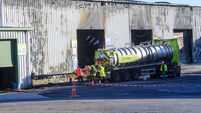Butterfly breeding a flutter of good news
So it’s very refreshing when you come across a good news story. And I think the fact that four species have been added to the list of Irish breeding butterflies over the past few years is good news. Real’s wood white joined the club in 2000 but it’s certainly not a new arrival. It’s just that up until then it was mistaken for the common wood white. This is understandable because the difference between the two is minute.
JM Harding’s definitive new book on Irish butterflies states: “Both species are indistinguishable in the field but their genitalia are different and they are clearly different species.” Certainly a matter for the experts.
Wood whites are delicate, fluttering butterflies and their upper wings are a pure milky white. But they always rest with their wings closed and the undersides are darker, looking as though a grey-green mould is growing on them. Despite the name, they are not exclusively woodland butterflies. They’re also found on damp, tussocky grassland and on bogland edges and regenerating cutaway. And, although Real’s wood white went undetected for so long, it’s not a rare butterfly. In fact it may be commoner than the common wood white everywhere except in the west. The trouble is that there haven’t been enough experts to monitor its distribution over the eight seasons since it was discovered.
A similar problem arises with the Essex skipper and the small skipper. To quote Mr Harding again: “The Essex skipper with a wingspan of 26-30 mm is slightly smaller than the small skipper, from which it is almost indistinguishable unless it is caught and its antennae are examined.” Both species are around the same size as the dingy skipper, which is a well established and fairly common Irish species, although its distribution is somewhat local.
Luckily both the new species are much more brightly coloured in brown and gold than the dingy skipper, which is largely grey, white and fawn.
They are called skippers because of their very rapid, bouncing flight, which makes both identification and capture something of a challenge.
The small skipper has been found at one site in Co Kildare, which it shares with the Essex skipper. The discovery was made in 2005 and the species appears to be thriving. The Essex skipper is also found at several sites in Co Wexford.
It’s a relief that the fourth new species, the comma, (see left and below) is a very easy butterfly to recognise. I’ve never seen one in Ireland but I’m familiar with them from other countries. They are fairly large, boldly patterned in brown and orange and have a very distinctive scalloped edge to their wings. When the wings are closed there is a white punctuation mark on each hind wing from which the species gets its name.
They are not unlike the small tortoiseshell and the caterpillars of both species share the same food plant: the stinging nettle. But the comma lacks the blue and white of the small tortoiseshell and that ragged wing edge is very distinctive.
As far as I know nobody has proved that the comma is breeding in Ireland. Most of the reports are of single individuals but they are coming from all over the country in increasing numbers. This is also a species with an expanding range that has recently colonised northern England, Scotland and the Isle of Man.
This is definitely a species to look out for if you’ve an interest in butterflies.
* dick.warner@examiner.ie














